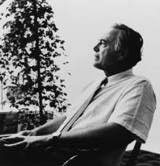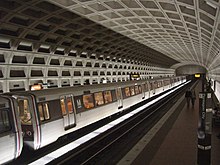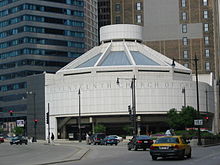Harry Weese
Harry Weese | |
|---|---|
 | |
| Born | June 30, 1915 |
| Died | October 29, 1998(aged 83) |
| Alma mater | Massachusetts Institute of Technology(SB 1938) |
| Occupation | Architect |
| Buildings | Arena Stage Time-Life Building The United States embassy inAccra, Ghana |
| Projects | Washington Metro |
Harry Mohr Weese(June 30, 1915 – October 29, 1998) was anAmericanarchitect[1]who had an important role in 20th century modernism andhistoric preservation.His brother,Ben Weese,is also a renowned architect.
Early life and education
[edit]
Weese was born on June 30, 1915, inEvanston, Illinois,as the first son of Harry E. and Marjorie Weese. His father was anEpiscopalian,and his mother was aPresbyterian.[2]In 1919, the family moved toa houseinKenilworth, Illinois,where Harry was raised. Weese was enrolled in theprogressiveJoseph Sears School in 1919. By 1925, Weese decided that he wanted to be either an artist or an architect.[3]
After graduating fromNew Trier High School,Weese enrolled at theMassachusetts Institute of Technologyin 1933 to earn a Bachelor in Architecture degree. Weese also took architecture classes atYale Universitystarting in 1936. Weese studied underAlvar Aaltoat MIT, and fraternized with classmatesI.M. PeiandEero Saarinen.As his schooling was at the height of theGreat Depression,Weese avoided studying expensive historical revival styles in favor of more-affordable modern styles. In the summer of 1937, Weese toured northern Europe on a bicycle, fostering his appreciation for the modernist movement.[3]
Upon his return to the United States, Weese was offered a fellowship at theCranbrook Academy of Art[3]) through Eero Saarinen, whose fatherElieloversaw the school. At Cranbrook Academy of Art, he studied city planning, pottery, and textiles while learning more about Modernist principles. He worked alongside other emerging Modernist designers such asRalph Rapson,Florence Knoll,andCharles Eames.[3]
Career
[edit]
Weese formed an architectural partnership in Chicago with classmate Benjamin Baldwin upon their graduation in 1940.[3]He would later marry Baldwin's sister, Kitty.[3]Following the brief partnership, Weese joined the firm ofSkidmore, Owings and Merrill(SOM). Soon after joining, however, Weese enlisted as an engineering officer in theUnited States NavyforWorld War II.Weese moved back to Chicago after the war in 1945 and rejoined SOM.
In 1947, Weese started his independent design firm, Harry Weese Associates. His first commissions, such as theRobert and Suzanne Drucker HouseinWilmette, Illinois,were houses for family members and close associates. By the late 1950s, Weese began to receive major commissions. Although he continued to plan houses, Weese also built civic projects such as theMetropolitan Correctional Centerin Chicago.
TheWashington Metroin theDistrict of Columbiahelped Weese become the foremost designer of rail systems during the peak of his career. He subsequently was commissioned to oversee rail projects inMiami,Los Angeles,Dallas,andBuffalo.[citation needed]He was named aFellow of the American Institute of Architectsin 1961 and received the Arnold W. Brunner Memorial Prize from theNational Institute of Arts and Lettersin 1964.[4]
Weese was also well known for his firm advocacy ofhistoric preservation,and was remembered as the architect who "shaped Chicago’s skyline and the way the city thought about everything from the lakefront to its treasure-trove of historical buildings".[5]He led the restoration ofAdler & Sullivan'sAuditorium Building,andDaniel Burnham'sField Museum of Natural HistoryandOrchestra Hall.Harry Weese & Associates received theArchitecture Firm Awardfrom theAmerican Institute of Architects(AIA) in 1978. Weese also served as a judge for theVietnam Veterans Memorialdesign competition, and helped defend fledgling architectMaya Lin's unconventional design against her critics.[1]
In the late 1970s, Weese was involved in the inception of the effort to host a1992 World's Fair in Chicago.During that same period, he was also the prime mover in the preservation, rehabilitation and adaptive reuse ofChicago's Printer's Row neighborhood,converting loft buildings that had once housed printing industry firms into apartments and offices, thus proving the economic viability of repurposing urban historic buildings.[6]
From the mid-1980s, Weese drank heavily and his reputation faded; he died after years of going in and out ofalcohol rehabilitationand a series of disablingstrokes.[3][7][8]
Personal life
[edit]Weese's parents wereProtestantChristians,but he himself wasnon-religious.While being interviewed by the building committee of theSeventeenth Church of Christ, Scientistin Chicago, when asked of his religious views, he said, "My father was Episcopalian, my mother Presbyterian, and I’m an architect".[2]
Legacy
[edit]In a 1998 obituary, architectural criticHerbert Muschampwrote that "Mr. Weese designed a systemwide network of stations that rank among the greatest public works of this century", referring to his design of the Washington Metro system. Muschamp noted that the vaulted ceilings at the crossings of subway lines "induce an almost religious sense of awe".[1]
In 2007, the design of the Washington Metro's vaulted-ceiling stations was voted number 106 on the "America's Favorite Architecture"list compiled by theAmerican Institute of Architects(AIA), and was the onlybrutalistdesign to win a place among the 150 selected by this public survey. In January 2014, the AIA announced that it would present itsTwenty-five Year Awardto the Washington Metro system for "an architectural design of enduring significance" that "has stood the test of time by embodying architectural excellence for 25 to 35 years". The announcement cited the key role of Harry Weese, who conceived and implemented a "common design kit-of-parts" which continues to guide the construction of new Metro stations over a quarter-century later.[9]
Works
[edit]

Weese is best known as the designer and architect of the first group of stations in theWashington Metrosystem. Other well known works include:
- 1952 - Davis Clinic, Marion, Indiana - a new model for delivering healthcare.
- 1954 -Robert and Suzanne Drucker HouseinWilmette, Illinois
- 1956 -227 East Walton Place Apartment Buildingin Chicago, now aChicago Landmarkbuilding
- Alpha Sigma Phi,Alpha Xi Chapter House atIllinois Institute of Technologyin Chicago
- The United States Embassy Building,Accra, Ghana,closed in 1998
- 1960 -Arena Stage,Washington DC(remodeled in 2010 byBing Thom Architects)
- 1960 -Pierce Tower,undergraduate residence hall at theUniversity of Chicago(demolished 2013)
- 1963 -St Thomas' Episcopal Church, (Menasha, Wisconsin)Similar to the First Baptist Church, Columbus, Indiana, but with a more sweeping roof design and towering steeple.
- 1963 - Sterling Morton Library, TheMorton Arboretum
- 1965 -First Baptist Church,inColumbus, Indiana
- 1966 - Fewkes Tower at 55 W. Chestnut Street (formerly 838 N. Dearborn Street), Chicago[10]
- 1968 -Seventeenth Church of Christ, Scientist,Chicago
- 1969 -Time-Life Building,Chicago[5]
- 1969 -Marcus Center for the Performing Arts,Milwaukee
- 1969 - Humanities Building at theUniversity of Wisconsin–Madison,widely considered one the Midwest's best examples of brutalist architecture but slated for demolition by 2030.[11]
- 1969 - The Upper School (high school) building ofThe Latin School of Chicago,Chicago
- 1970 -Formica Building,Cincinnati
- 1972 -The Given Institute,Aspen Colorado (demolished 2011)
- 1973 - WestinCrown CenterHotel, Kansas City, Missouri
- 1975 - Mercantile Bank,Kansas City, Missouri
- 1975 -Oak Park Village Hall,Oak Park, Illinois
- 1975 - William J. Campbell United States Courthouse Annex in downtown Chicago (formerly known as theMetropolitan Correctional Center, Chicago.) Federal temporary holding prison which has no window bars, instead each cell is provided with a vertical 5 "slot window. Weese was mandated to follow then new federal prison architectural guidelines, like cells having no bars and by original design each prisoner was housed separately.[12][13]
- 1977 - O'Brian Hall at theState University of New York at Buffalo
- 1979 - Middletown City Building,Middletown, Ohio
- 1981 -Fulton House,345 N. Canal Street, Chicago. Converted 19th century 16-story cold-storage warehouse building to condominium building.
- 1985 -411 East Wisconsin Center,Milwaukee
- Chazen Museum of Artat the University of Wisconsin–Madison, formerly known as the Elvehjem Museum of Art
- River Cottages at 357-365 N. Canal Street, Chicago. Sloped, structurally expressive facade responds to the angle and cross bracing of the railroad bridge directly across the river.
- The Healey Library,University of Massachusetts Boston
- Swissôtel, Chicago. The cross-section is an equilateral triangle, so that two-thirds of the rooms have a view of the main stem of theChicago River.
Weese also led numerous restoration projects including:
- 1967 -Louis Sullivan'sAuditorium Buildingin Chicago (1967)[5]
- Field Museum of Natural History,Chicago[1]
- Orchestra Hall,Chicago[1]
- Union Station,Washington, D.C.[1]
Weese designed over 80 single home and residential buildings, including:
- His primary residence in Barrington, Illinois
- "Shadowcliff", Ellison Bay, Wisconsin
- Evanston, Illinois
- Glen Lake, Michigan
- Muskoka Lakes, Ontario, Canada
- Red House, Barrington, Illinois
- Tangeman House, Ontario, home ofClementine Tangemanand Robert Stone Tangeman[14]
- Wayne, Illinois
References
[edit]- ^abcdefMuschamp, Herbert (November 3, 1998)."Harry Weese, 83, Designer Of Metro System in Washington".The New York Times.Retrieved2016-02-15.
- ^abMayer, Ellen (October 22, 2014)."Real Estate And Religion: The Tale Of Seventeenth Church Of Christ, Scientist".WBEZ.Retrieved2023-02-24.
- ^abcdefgSharoff, Robert (July 7, 2010)."On the Life and Work of Chicago Architect Harry Weese".Chicago Magazine.RetrievedOctober 20,2014.
- ^"Awards: Arnold W. Brunner Memorial Prize".National Institute of Arts and Letters.RetrievedFebruary 24,2023.
- ^abcKamin, Blair (November 1, 1998)."Harry Weese, Visionary Architect Known as 'Chicago's Conscience'".Chicago Tribune.RetrievedFebruary 24,2023.
- ^"Landmark Designation Report"(PDF).Chicago Department of Housing and Economic Development. March 1, 2012.Archived(PDF)from the original on 21 November 2022.RetrievedApril 29,2023.
- ^Baldwin, Ian (May 2011)."The Architecture of Harry Weese: Chicago modernist".Places Journal.Retrieved2016-04-16.
- ^Kahn, Eve M. (3 January 2011)."The Complexities of a Pioneering Architect".Architect: The Journal of the American Institute of Architects.Retrieved2016-08-27.
- ^Mortice, Zach."2014 Twenty-five Year Award".American Institute of Architects.Archived fromthe originalon 2015-04-19.Retrieved2014-02-11.
- ^Gallun, Alby (October 22, 2014)."Teachers union selling Gold Coast apartment tower".Crain's Chicago Business.RetrievedFebruary 24,2023.
- ^Schmitt, Preston (Spring 2021)."How the Humanities Building Went Wrong".On Wisconsin.Retrieved24 February2023.
- ^Waldheim, Charles; Ray, Katerina Ruedi (2005).Chicago Architecture: histories, revisions, alternatives.Chicago: University of Chicago Press. p. 285.ISBN978-0-2268-7038-0.
- ^"Biography of Harry Weese".The Art Institute of Chicago.p. 179-ff. Archived fromthe originalon 2010-01-05.
- ^Bruegmann, Robert (2010).The Architecture of Harry Weese.New York, USA: W.W. Norton & Co. p. 111.ISBN9780393731934.
Further reading
[edit]- Weese, Kitty Baldwin; Weese, Harry (August 1987).Harry Weese Houses.Chicago Review Press.ISBN978-1-5565-2012-9.
- Bruegmann, Robert; Skolnik, Kathleen Murphy (2010).The Architecture of Harry Weese.New York: W.W. Norton.ISBN978-0-3937-3193-4.
External links
[edit]- Oral history interview with Harry Weese- Art Institute of Chicago.
- Modernist architects from the United States
- Harry Weese buildings
- Preservationist architects
- 1915 births
- 1998 deaths
- Architects from Chicago
- Artists from Evanston, Illinois
- Fellows of the American Institute of Architects
- MIT School of Architecture and Planning alumni
- Cranbrook Academy of Art alumni
- 20th-century American architects
- 20th-century American historians
- People from Kenilworth, Illinois
